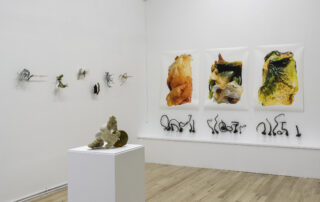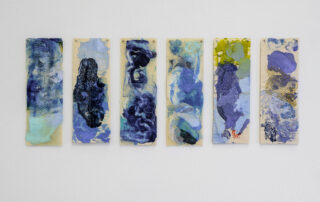Photography: Katia Klose
Bær / A Place
Markus Baenziger (US), Barbara Ellmann (US), Katia Klose (DE), Jóna Þorvaldsdóttir (IS), Debbie Westergaard Tuepah (CA), Mike Vos (US)
Curator: Daría Sól Andrews
Gallery 4
8th february – 24th August 2025
A PLACE presents a group exhibition of six international artists brought together in 2022 during an artist residency at Bær Art Center in Höfðaströnd in Skagafjörður, Iceland. The artists are, Barbara Ellmann, Jóna Þorvaldsdóttir, Mike Vos, Katia Klose, Debbie Westergaard Tuepah, and Markus Baenziger. The exhibition A PLACE, at Listasafn Árnesinga is a sort of second edition and continuing exploration of this original residency experience from 2022, exploring the lasting connections, influences, and new impressions formed in the practices of each artist as a result of this residency and exhibition.
The artists spent two weeks together at the residency together. A strong connection and a whole formed between these different individuals, and works were created that functioned as a kind of storyline and a connection to the local community. Separate but intertwined artworks were created about each artist’s individual experience of nature, culture and place.
One year later, in summer 2023, an exhibition was presented at the Bær Art Center, showing the works that were produced during the residency period. And now, in this exhibition at Listasafn Árnesinga, A PLACE, presents a blend of works that were included in the previous exhibition, while also presenting new works each artist has developed since this residency. These new works were produced with the residency experience in mind, and we can feel the influence of the natural landscape of Iceland and the community surrounding Bær Art Center strongly in the works.
What connecting themes can be found when six artists, of unconnected and differing backgrounds and localities across the globe, come together in a residency in the remote countryside in Iceland? It becomes inevitable that the stark nature will influence each artist in a commonality across their works, through the connected experience. And when each artist returns to their everyday, how can this experience resonate into their practice?
The artists work with a range of mediums, from photography, sculpture, installation, and painting. There is a strong element of locality to the works, whether photographing local landscapes in Iceland, or utilizing site- specific and found natural materials from specific areas in Iceland in the works. The works still speak strongly together as a whole – what sort of common ground can we see in the practices of these six artists?
Mike Vos, for example, overlays urban landscapes and deteriorated buildings onto scenes of natural beauty across Iceland.
And in the installation by Debbie Westergaard Tuepah, she works with environmentally produced plastic from the area of Hveragerði, local to the town of the LÁ Art Museum, presenting an installation of found and manmade whale bones.
Jóna Þorvaldsdóttir presents conceptual and experimental analogue photography focusing on distinct natural details from the landscape of Höfðaströnd. Katia Klose’´s work explores seaweed from the area, in a vibrant and surreal photographic series. Markus Baenziger collected found materials from around the residency, natural and manmade, using them to create delicate and curious sculptural works. Barbara Ellmann’´s encaustic paintings and abstract sewn drawings reveal the natural elements of Iceland in a topography of movement and shifting tides.
The remote locality is essential to each of the works. From distinct and uncommon backgrounds, the artists were brought together in this moment, producing work together during the residency with the common thread of the influential natural landscape and experience of the Höfðaströnd area.
Markus Baenziger is a Swiss born artist living and working in Brooklyn, NY. He has shown extensively in the U.S. as well as internationally. He is a recipient of the John Simon Guggenheim Memorial Foundation Fellowship award, and his work was featured in solo exhibitions at the Edward Thorp Gallery, NYC, the List Gallery, Swarthmore College; the Cantor Fitzgerald Gallery, Haverford College, Tanya Bonakdar Gallery, NYC, and numerous group exhibitions including the Rose Art Museum, the Walker Art Center, the Walton Arts Center, the Yale University Art Gallery, among others. His work has been widely reviewed, and can be found in the collection of the Walker Art Center, MN, and numerous private collections.
My first response to the stunning landscape surrounding Bær was to simply go on walks and take in the experience. Eventually I came across various small pieces of plastic, fragments of fishing nets, and other flotsam washed up at the shore.
I started to collect them together with other materials from nature and created a series of small sculptures.They are inspired by the brightly colored rope that I found absorbed into the ground and entangled with the sea grass, or the small fragments of plastic tossed with the stone pebbles on the shore. I see these works as a reflection on the intersection of nature and the man-made world. They establish a dialogue between the beauty of our natural environment and our forceful positioning within nature, which is constantly absorbing the physical remnants of our presence.
Barbara Ellmann lives and works in New York. She’s exhibited work for forty years at venues including the Katonah Museum of Art, the Parrish Art Museum, Montclair Art Museum, and the Haslla Art World Museum. She has been selected for residencies at Yaddo, the Hermitage Artist Retreat, Haslla Art World Museum, and Baer Art Center. She has also produced public works for the MTA (Metropolitan Transit Authority), the City of Summit, NJ, and the Queens Public Library.
Recording memories of places, through observations and inventions, my work allows recognizable imagery to exist alongside pure abstraction within the same multi-panel installation. This series highlights the natural landscape with a focus on how water shapes not only the geography, but also one’s social, economic, and spiritual experience of life. In Iceland, I experienced a place where nature takes center stage in a way that feels both ancient and alive, thrilling and frightening in its power. A sense of geological time is written into the landscape features. The snow compacted to glacial ice might have fallen there over a thousand years ago, and yet an eruption might bring up lava from the core of the earth and lend new features to the ever-changing contours of the place. My known sense of ground had been a kind of neutral, static constant, whereas the dynamism of the landscape here felt like an inversion of time conflating past and present, a turning of an hourglass, and a startling reminder of interdependence. www.barbaraellmann.com
Katia Klose, born in East Berlin (Germany), lives in Leipzig. She studied graphic design at the Weißensee Academy of Art Berlin, photography at the Academy of Fine Arts Leipzig and photo editing at the Ostkreuzschule Berlin. She has been selected for several residencies in France, Germany and Iceland and got scholarships in Germany, Australia and Canada. She has shown extensively in Germany and the EU as well as internationally.
Katia Klose photographic work examines reality in all of its sensual and poetic qualities. Natural forms are reconfigured and re-examined when staged by the photographer as her subjects. Through documenting the environment in this way, her images reveal the hidden connections between human existence and nature. The series Seaweed (the hide) uses seaweed found on the black sand beach around Bær and arranges these specimens so they may seem unreal or surreal. Presented as negatives with varying shades of grey, blue and sienna, the images from the series : iInversive act as a form of disengagement from reality. The mountains are otherworldly, somewhat muted and magical.
Jóna Þorvaldsdóttir is a fine art photographer based in Reykjavík who only works in analogue photography, especially in historic techniques in her darkroom. Jóna’´s work is strongly influenced by Icelandic folktales, where hidden creatures and beings lurk, eager to reveal themselves and stir our imagination. This fascination with the unseen, is beautifully reflected in her soft and dreamlike images. Her dedication to black and white analogue photography, allows her to create images that evoke a sense of timelessness and introspection. Her images often transcend stark reality as she strives to present them from unique perspectives that challenge conventional norms. Employing traditional and alternative photographic processes such as palladium, bromoil and silver gelatine, require meticulous craftsmanship. The sacred space of her darkroom becomes integral to her creative journey, where she immerses herself in the transformation of film into tangible prints. It is within this realm that magic happens, where happy accidents and boundless imagination find their expression.
Debbie Westergaard Tuepah is a Canadian artist working primarily in sculpture. She exhibits internationally and is the recipient of numerous awards. Notable exhibitions include Surrey Art Gallery, The Reach Gallery Museum, Vancouver Art Gallery, and Bellevue Washington’s Sculpture Biennial.
Roaming Bær gave me space to consider the precariousness of the world, collect detritus, and study the detrimental impact of plastics on living organisms. Found plastics bore evidence of degradation into microplastics and nanoplastics, which exist in water, sediments, air, rain, and ice; and the bodies of humans and other creatures. Combined with the discovery of cetacean vertebrae and animal bones, this relationship between plastics and life materialized strongly in my work. In Tender Rituals VI, 3D printed whale vertebrae hover over dark pebbles, but the materials are in question. Bones that seem plastic are compostable and biodegradable, while the pebbles are in fact recycled plastics that are destined for reuse: both are materials of hope from forward-thinking companies. Tender Rituals IV ’s cetacean bones and worn metal fishing floats connect the work to fishing related litter such as nets, while Tender Rituals VII incorporates a degraded fishing float enveloped in an animal bone. Both embody the relationship between plastics and living creatures.
Pebbles in Tender Rituals VI were generously provided by Pure North Recycling in Hveragerði.
Mike Vos is a photographer, visual artist and musician from Portland, OR. Drawing inspiration from various literary movements and themes, Vos uses traditional and experimental 4×5 film techniques, multi-channel video, field recordings and instrumentation to craft complex narratives that advocate for the preservation of wild spaces. Constantly pushing the capabilities of film photography, analog video and sound, Vos creates immersive experiences to draw viewers into surreal representations of physical places. Vos has exhibited work and attended artist residencies across the United States, Mexico, Canada and Iceland. In 2024 he was awarded a fellowship with The Sitka Center for Art & Ecology in Oregon and released his debut monograph ‘Somewhere in Another Place’ through Buckman Publishing.

















































